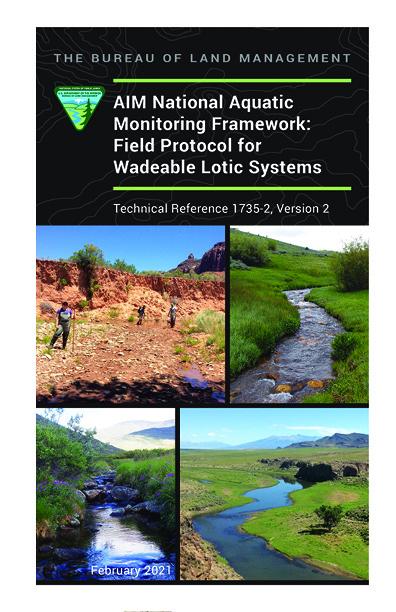AIM National Aquatic Monitoring Framework, Field Protocol for Wadeable Lotic Systems, TR1735-2

The Bureau of Land Management (BLM) developed the National Aquatic Monitoring Framework (NAMF) (Miller et al. 2015) to monitor the condition and trend of aquatic systems as part of the Assessment, Inventory, and Monitoring (AIM) Strategy (Toevs et al. 2011). Following the AIM principles, the NAMF standardized field sampling methodologies, electronic data capture, and the use of appropriate sample designs for wadeable streams and rivers (i.e., lotic systems). The protocol in this technical reference outlines standardized core and contingent field methodologies for wadeable lotic systems, as well as suggested covariates.
Following 3 years of implementation of the protocol in this technical reference, application of data and management decisions, and studies on the repeatability of the field methods, Version 2 of the protocol reflects the following updates:
- Omits U.S. Environmental Protection Agency methods for the ocular estimate of instream habitat complexity and riparian vegetative type, cover, and structure for streams in the continental U.S. because of high field measurement variability among crews and low discriminatory efficiency among BLM streams.
- Changes the riparian vegetation core method to focus only on estimates of the frequency of occurrence of priority noxious vegetation based on standardized state species lists.
- Adds a contingent method for assessments of the frequency of occurrence of priority native woody riparian vegetation based on standardized state species lists.
- Updates the bank cover method to ensure foliar and not basal cover is estimated to maintain compatibility with existing protocols.
- Adds pool tail fines as a contingent method.
- Adds guidance for the monumenting of stream reaches.
- Adds Appendix G for integrating multiple indicator monitoring (MIM) procedures with the AIM lotic protocol.
- Adds Appendix H for implementing the AIM lotic protocol in Alaska.
- Clarifies protocol verbiage to ensure accurate implementation and repeatable measurements among data collectors.
Building on the work of the BLM AIM Aquatic Core Indicator Work Group (ACIWG) and guidance from an external science advisory team, the protocol contains 11 core methods, 8 contingent methods, and several covariates applicable to lotic systems (Table 1). The 11 core methods represent a consistent, quantitative approach for determining the attainment of BLM land health standards for perennial wadeable streams and rivers, among other applications (Miller et al. 2015). AIM lotic core methods are standardized procedures for collecting data that are applicable across many different ecosystems, management objectives, and agencies and are recommended for application wherever the BLM implements monitoring and assessment of streams and rivers. To help determine the potential of a stream reach to support a given condition or to assist in interpreting monitoring data, the ACIWG also identified six lotic covariates—slope, bankfull width, wetted width, human influence, photos, and flood-prone width (Table 1). For example, slope is useful in interpreting pool frequency, large wood retention, and percent fine sediment. Measurement of the field covariates is recommended in conjunction with the core methods.
